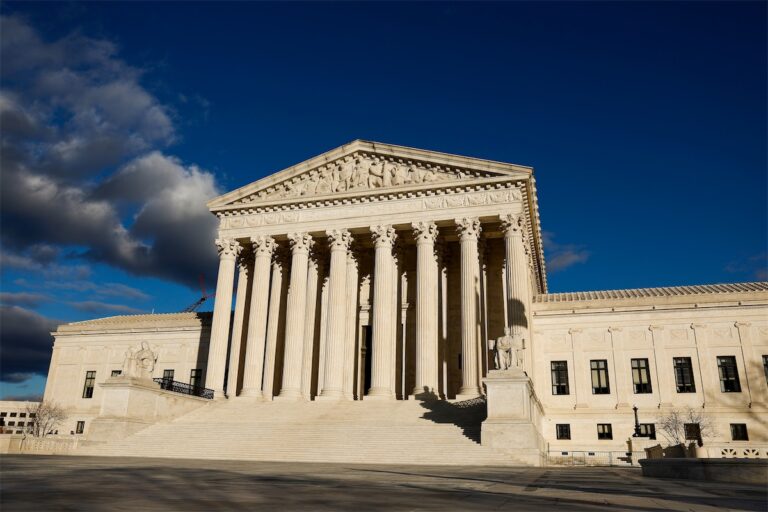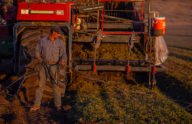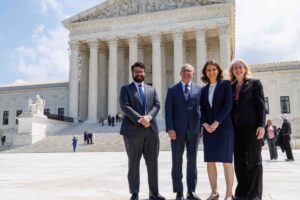How does a case get to the Supreme Court?

“I’ll take it all the way to the Supreme Court.” It’s far easier said than done, and it can take years for a legal battle to wind its way through the courts. When the federal government is on the other side—as it often is in Pacific Legal Foundation cases—it takes a relentless, determined attitude to press on, sometimes for more than a decade. The wheels of justice turn slowly, as the saying goes.
First: What kind of cases does the Supreme Court hear, and how do the Justices decide which cases to take?
The Supreme Court has two kinds of authority: appellate jurisdiction and original jurisdiction.
(1) Under its appellate jurisdiction, the Supreme Court may hear cases that involve a federal constitutional question arising from state courts. For example, Pacific Legal Foundation’s 1990 Supreme Court victory, Keller v. State Bar of California, about whether government-mandated professional organizations can compel members’ speech, went to the Supreme Court after PLF lost at the California Supreme Court.
The Supreme Court also may hear cases that come from federal courts. For example, PLF’s 2023 victory in Sackett v. EPA, challenging the EPA’s authority to broadly expand the Clean Water Act’s definition of “navigable waters,” went to the Supreme Court after PLF lost at the U.S. Court of Appeals for the Ninth Circuit.
(2) Under its original jurisdiction, a case starts and ends in the Supreme Court. These typically are disputes between states over borders or interstate waters. For example, in the 1998 case New Jersey v. New York, the two states fought over which controlled filled land that expanded Ellis Island and was not part of a relevant interstate compact from the 1830s. The case was argued before the Supreme Court, where the Justices decided that New Jersey had authority over the filled land.
Before the appeals from state and federal courts can be considered by the Supreme Court, they usually must make their way through two lower courts. (Naturally, there are exceptions, such as Congress authorizing direct appeal to the Supreme Court from three-judge district court panels for cases arising under the Voting Rights Act.)
(1) District courts resolve both legal and factual issues, which may involve both sides calling witnesses to present testimony and offering evidence. In district court, the parties make their arguments to a judge (or jury) and either win or lose. The losing party has the option to appeal the case to the circuit court.
(2) Circuit or appellate courts review the district court’s record and look for legal errors. Parties typically appear before a three-judge panel to present oral arguments, and the judges ask questions (sometimes rapidly!) to test both parties’ legal theory. The panel then writes an opinion explaining its ruling, which sometimes requires a lot of waiting. In Cedar Point Nursery v. Hassid, PLF waited a year and a half for a decision from the circuit court.
At this point, a losing party has two choices for continuing to press their case: request rehearing “en banc,” meaning the full circuit court (or a larger panel for courts like the 29-judge Ninth Circuit) hears oral arguments again and issues another opinion. Or, the losing party may choose to skip this step and go straight to the Supreme Court.
To appeal to the Supreme Court, the losing side files a petition for a writ of certiorari.
A writ of certiorari is the document the Court issues when it agrees to hear a case. Filing a petition for a writ of certiorari does not guarantee that your case will be heard. The Court receives around 8,000 petitions each term and agrees to review less than 1 percent. Last term, it heard just 59 cases. As the Court has explained, “Review in this Court by means of a writ of certiorari is not a matter of right, but of judicial discretion.” That’s because the Justices’ primary concern is to decide cases that present issues of broader significance than the facts and parties in one particular case. The Court reviews “cert” petitions on certain “conference days” during its term, which begins in October and ends at the beginning of July.
The Justices are not interested in taking cases just because a lower court may have gotten it wrong.
Justices look for some of the following criteria for cases they will agree to hear:
(1) The case addresses a question of national importance. For example, during the COVID pandemic, the Court heard National Federation of Independent Business v. Department of Labor, Occupational Safety and Health Administration, which challenged a mandate that employers with at least 100 employees require covered workers to receive a COVID-19 vaccine.
(2) The case addresses issues where circuit courts disagree about how to interpret a law or constitutional provision, so much so that individuals are unclear as to what the actual law is. That’s what happened in PLF case Tyler v. Hennepin County, where state and federal courts were split on whether the Constitution prohibits states from taking a person’s home to satisfy an unpaid tax debt and keep far more than they are owed.
Other considerations include when a lower court invalidates a federal statute or a petition asks the Justices to overturn one of their precedents.
Here’s what the journey to the Supreme Court looks like in real life:
Take the case of Wil Wilkins, a stonemason, timber framer, and blacksmith. He owns and lives on property next to the Bitterroot National Forest in Montana. In 1962, a previous owner gave the U.S. Forest Service a limited-use easement to use a road on the property to access the forest only for the purpose of timber harvesting.
Fast forward to 2006, when the Forest Service posted a sign along the road advertising “public access” to the forest. Over Wil’s protests, the Forest Service allowed the public to start using the road. This led to speeding cars, traffic congestion, and intrusive and disrespectful activity such as fire threats, trespassing, verbal abuse, and illegal hunting. In fact, a neighbor’s dog was killed by a speeding driver, and Wil’s cat was shot by a trespasser (thankfully, Mr. Kitty recovered).
Over the course of eight years, Wil tried to appeal to the Forest Service. When that didn’t work, he sued under the Quiet Title Act, a federal law authorizing suits to settle property disputes with the government. The case worked its way through the district and circuit courts, which both agreed with the government that the statute of limitations had run out. In other words, Wil had waited too long to sue, and the courts said he was out of luck. But Wil didn’t give up. He asked the Supreme Court to hear his case.
It was a longshot, as nearly every cert petition to the Supreme Court is.
But the Justices agreed to hear Wil’s case, and last March the Court ruled in his favor.
The reason the Justices took up Wil’s case was not because of how sympathetic he was (though that doesn’t hurt!) or even because of how unjust the Forest Service’s action was (that definitely doesn’t hurt!). The Court heard the case because it needed to resolve a disagreement among the circuit courts about whether being outside the statute of limitations deprived a court of jurisdiction to hear a case, or if that simply was an affirmative defense the government may raise. In recent years, the Supreme Court ruled on similar jurisdictional questions in cases involving copyrights, federal tort claims, Veterans Court appeals, and so forth. It was time to apply that to the quiet title law.
Despite the public perception, the Supreme Court is not always the end of the road. Indeed, when you’re up against one of the alphabet-soup agencies, the process is the punishment.
Seventeen years after the Forest Service put up a public access sign, Wil won the ability to continue pressing his suit to resolve the dispute over the government’s easement on his property. That case continues.
Similarly, it took the Sacketts 15 years and two trips to the Supreme Court to prevail against the Environmental Protection Agency’s wrongheaded determination that their land-locked, bone-dry Idaho property could be regulated as wetlands. That ultimately resulted in a win for the Sacketts and property owners, generally, because the Court clarified the scope of the agency’s authority to regulate “navigable waters” under the Clean Water Act.
Likewise, Arlen Foster, a corn farmer in South Dakota, has been embroiled in a dispute over an eight-inch-deep puddle with the U.S. Department of Agriculture since 2011. The presence of that puddle has forced Foster to choose between eligibility for certain federal subsidies and productively farming his land. Early in 2024, the Justices will consider whether to take up Arlen’s case, which offers the Court not only a chance to review the USDA’s duties under the “Swampbuster” Act, but also lower courts’ deference to agencies in the face of statutory silence.
At Pacific Legal Foundation, we aim to take as many cases “all the way to the Supreme Court” as needed to vindicate our clients’ rights. And our clients demonstrate the relentless, determined spirit that is necessary to take on the federal government.








